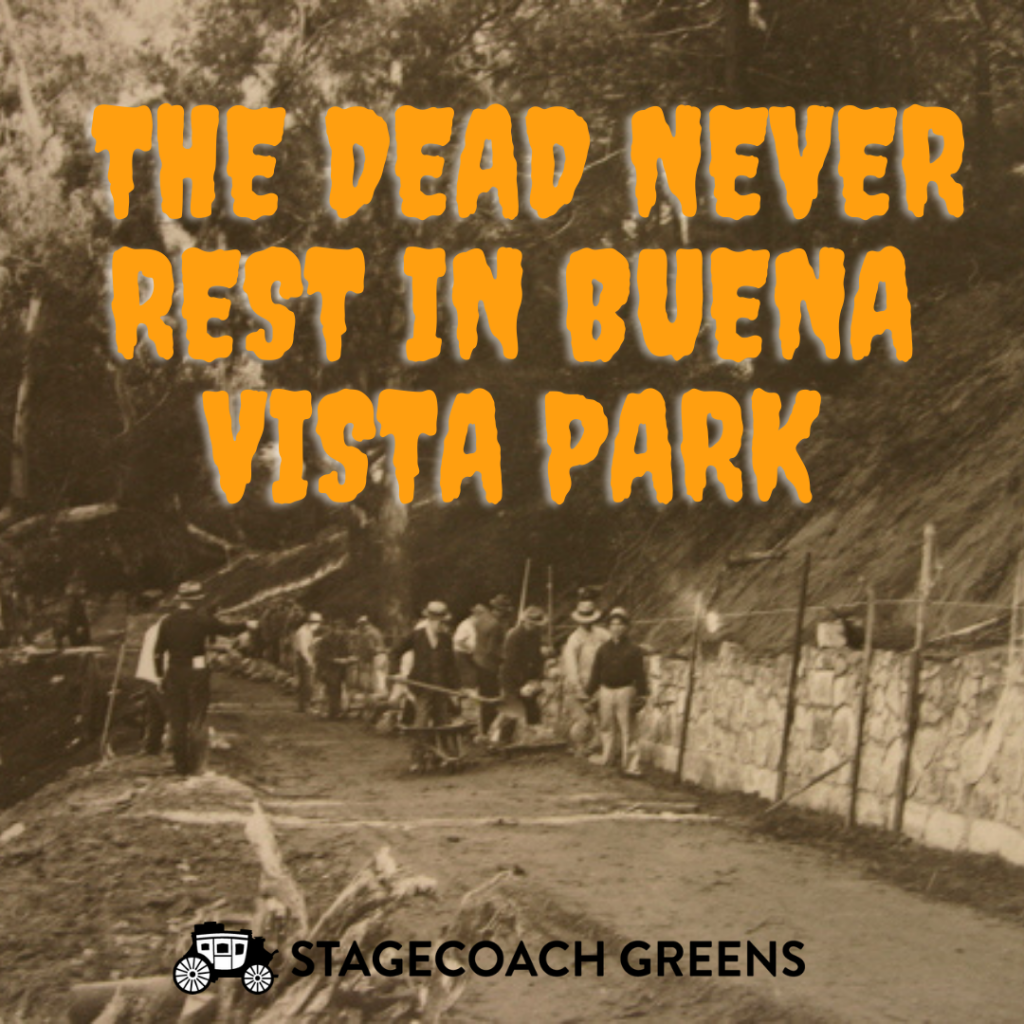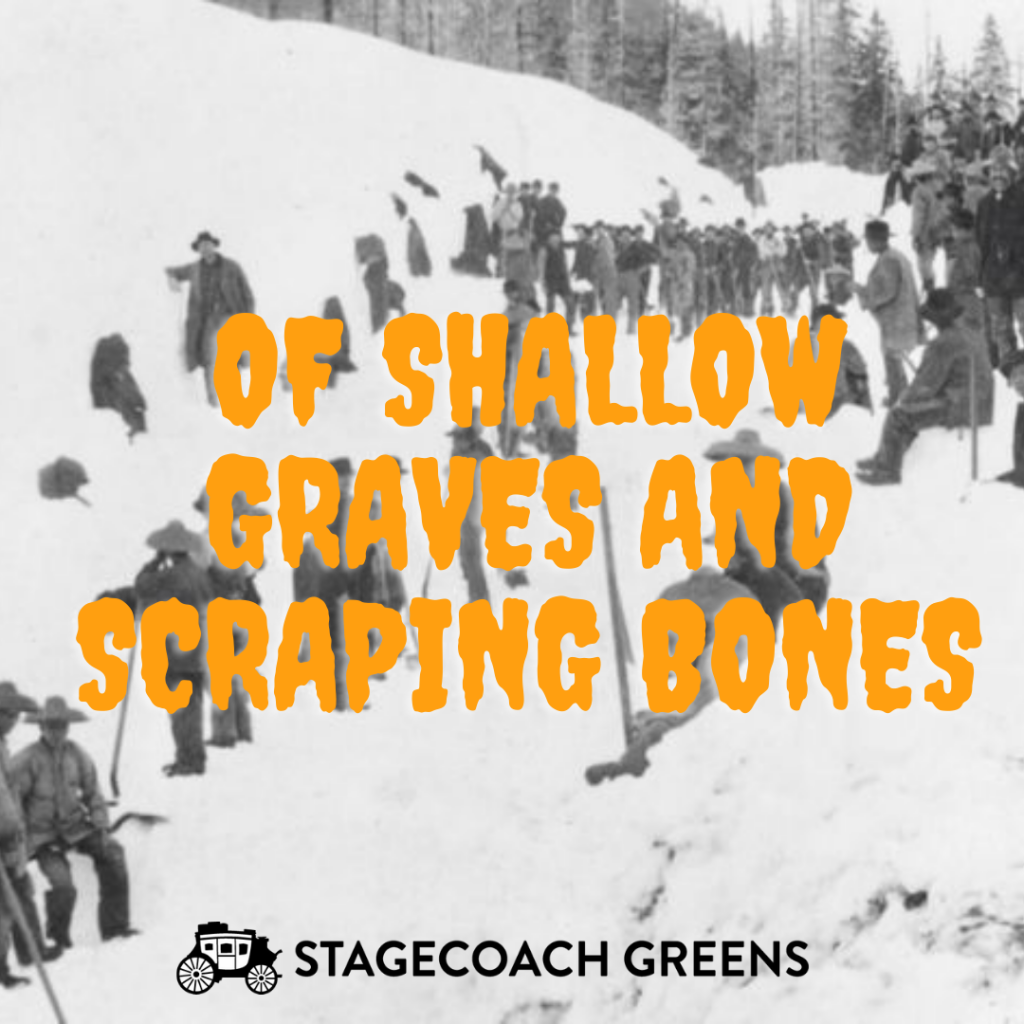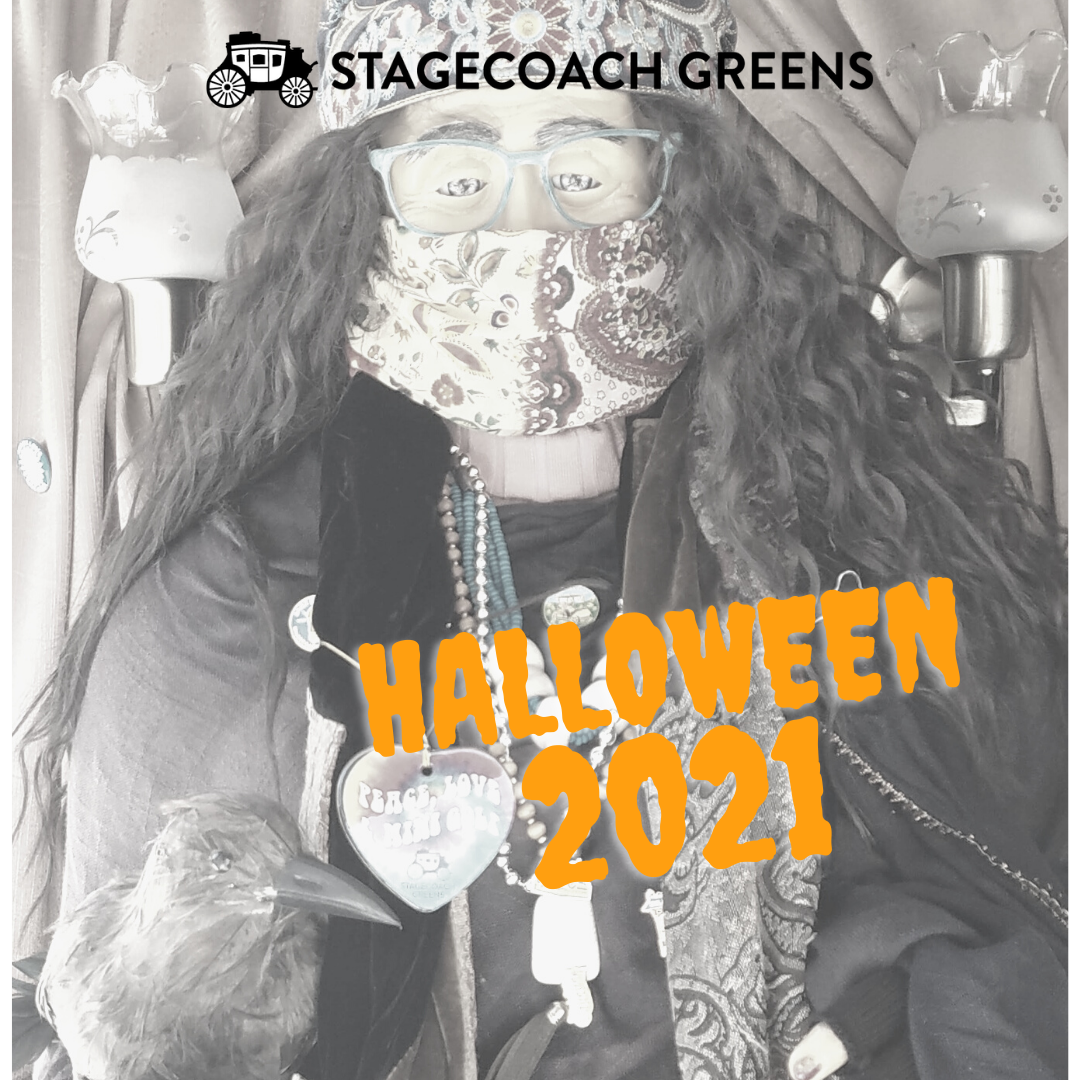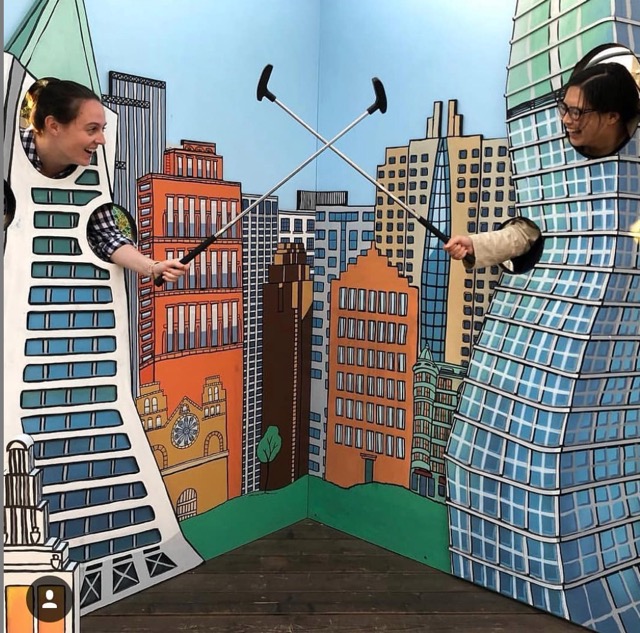BOO! AND BUST: 18 REAL SF GHOST STORIES COME TO LIFE AT STAGECOACH GREENS
By Stagecoach Screams—October, 2020
Halloween is our favorite season in San Francisco – sadly, we can’t host our epic Halloween party this year but get your costumes ready and your tickets and tee times – we have transformed the course so you can play your way through SF's Haunted History! Before you come, check out our inspiration of real-life super scary ghost stories from old San Francisco!

The Washoe tribe called Lake Tahoe home for more than 2,000 years before the arrival of settlers and features the Org – a monster bird that snatched and ate people who dared to venture out alone, and explains why the drowned never rise in Lake Tahoe.
"The Legend of Tahoe," originally shared in written form by Nonette V. McGlashan and published in Sunset Magazine on November 3, 1905.
“The old Indian woman glanced furtively at the distant sky line, and then centered her gaze upon the deep crystal waters of the lave. The Ong? she said. I will tell you of the Ong. The Ong was a huge bird, greater than the houses of the white men. Its body was like the eagle's, and its wings were longer than the tallest pines. Its face was that of an Indian, but covered with hard scales, and its feet were webbed. Its nest was deep down in the bottom of the lake out in the center, and out of the nest rushed all of the waters which fill the lake. There are no rivers to feed the lake, only the waters from the Ong's nest. All the waters flow back near the bottom, in great undersweeps, and after passing through the meshes of the nest are sent forth again. Every plant and bird and animal that gets into these under currents, and sometimes even the great trout are swept into the meshes of the nest and are there held fast to furnish food for the Ong.
He ate everything, he liked everything, but best of all he liked the taste of human flesh. No one ever heard or saw anything of such poor mortals as were drowned in these waters, for their bodies were carried to the Ong's nest and no morsel ever escaped him. Sometimes he would fly about the shores in quest of some child, or woman or hunter, yet he was a great coward, and was never known to attack anyone in camp, or when two or more were together. No arrow could pierce his feathers, nor could the strongest spear do more than glance from the scales on his face and legs, yet his craven's heart made him - afraid, for his toes had no claws, and his mouth no beak.”
Read the rest here:
The original copy of this writing is shared with the public via the California Digital Newspaper Selection, which gives access to the newspapers of California written in the 1800s.

Miss Piggott was a ferocious old woman who operated a saloon and boarding house in the raw and raucous Barbary Coast during the 1860s and 1870s. She also acted a bartender and bouncer. Her weapon of choice was a wooden mallet that doubled as a bung starter, used to knock the bung out of the whiskey barrels.
On the side she procured young men for ships crews that were shorthanded. Her hired man would prowl the streets looking for healthy young men and entice them to visit Miss Piggott’s place where she’d set up the drinks. Slowly the man would be nudged along the bar until he was standing atop a trap door where she would give him the “Miss Piggott Special” a concoction of equal parts of brandy, whiskey and gin laced with liberal amounts of laudanum or opium.
While the victim was shivering under the impact she would lean over and whack him on the head with her mallet. Then she’d pull a lever and he’d drop into the basement. When the young man awoke he was on board a sailing vessel with no clear idea how he got there.
Miss Piggott’s regular customers knew the exact location of the trap door and steered clear of it as it was an unwritten law that any man who stood on it was fair game.
Source: https://www.sfgate.com/bayarea/article/Waterfront-spot-where-the-drinks-had-a-brutal-4969060.php

Everyone knows the story of the doomed Donner Party expedition. Legend has it that the restless ghosts still wail and cry in fear and starvation around Donner Lake. There have been many tales told of travelers who, not knowing what had occurred in the ruined cabins along the lakeshore, stayed the night before crossing the pass and experienced the phantoms of those who died, or were murdered, years before. These same stories tell of mournful wails and ghostly figures whose confused spirits still roam the area.
Many years after the horrible events, the ruins at the site were turned into a monument of sorts to the tragedy that occurred. The crumbling stone walls of the Murphy cabin were marked with a monument, as were the sites of the Breen and Keseberg shelters. It is near the Keseberg cabin that an inordinate amount of strange activity has been reported over the years. Many believe that it may be the ghost of Tamsen Donner who lingers here, perhaps because of the mystery surrounding her cause of death. According to another emigrant, Lewis Keseberg, she had come to the shelter already sick from a fever, likely caught after falling into the creek and then running through the cold woods at night. Keseberg would later admit to cannibalizing Tamsen but some believe that he may have murdered her, rather than wait for her to die. He was charged with her murder but the case never went to trial. Eliza Donner always believed Keseberg's story that her mother had died from the fever, but the truth will never be known for sure.
These unanswered questions are what allegedly cause Tamsen's spirit to continue to walk. In recent years, there have been reports of an apparition sighted nearby that looks like a woman dressed in white. In addition, ghost researchers have also recorded voices and sounds with recording devices that sound like a woman weeping. Could these sounds be the voice of Tamsen Donner, still crying out from the other side?
Another active site is the former location of the Murphy cabin. The cabin is long gone now but a large stone remains that was used as a fireplace wall. This has long been thought to be the most eerie location in what is now a state park, dedicated to the Donner Party.
Source: https://seeksghosts.blogspot.com/2019/06/phantoms-of-donner-party.html

Established first as a ranch in the 1840s, this adobe in Soledad has been in the middle of history many times. It failed as a ranch when a drought in the early 1800s suffocated the Salinas Valley. It was then converted into an inn and brothel. It was at one point a post office and stage station for Wells Fargo riders.
There are reports of cries coming from underground that some have attributed to trapped miners – or to the souls of murdered men who were rooming in the adobe and whose bodies were reportedly dumped into the nearby well.
Other sightings include men in Old Western garb. The most menacing, however, is the Lady in Black. Some have concluded she is a witch while others have reasoned she was probably the madam of the brothel at some point. Either way, with either her bony finger or a stick, she’s been spotted pointing in the direction of the well, waiting for onlookers to notice. Some guests say that she laughs at them when she notices how horrified they look.
The TV Show Ghost Adventures filmed here. See more about the episode here

The eerie area of abandoned coal mines on Somersville Road in Antioch was named one of the seven most haunted sites in all of California. Visitors have reported seeing a ghostly white apparition, the White Witch. There are several stories about who she was. Maybe a nanny named Mary who cared for miners’ children in the late 1870s — children who fell mysteriously ill and died. She was accused of witchcraft and hanged. Or she might have been a midwife who died after a carriage accident, and who, on her deathbed, insisted there be no funeral for her. The townspeople threw one anyway (which was interrupted by a sudden terrible storm), buried her at Rose Hill Cemetery, and she’s still mad about it.
Read more about the hauntings here

In 1900, cemeteries were banned in San Francisco and by 1937 many were removed. Those tombstones that went unclaimed, and thus not relocated, were broken up and used in the building of Buena Vista Park, mostly in the walls and walkway gutters. Although in general the inscriptions on the tombstones are laid face down, there are a few exceptions due to mistakes made at the time the stone was placed. Ghostly activity in the park includes strange figures, voices and the sounds of people walking along the trails when no one is present, and an odd green glow moving through the trees. The park has also been rumored to have been the dumping ground for bodies from both serial killers and the mafia.
See a paranormal investigators roundup here

Coloma is the site of a historical monument to James Marshall, the man credited with starting the Gold Rush when he found two nuggets at Sutter’s Mill. Marshall may have regretted publicizing the find, as he was followed and stalked for the rest of his life by desperate prospectors. Many assumed Marshall had a special touch for finding the precious metal, or perhaps that he had a secret stash hidden away.
Today, Marshall’s ghost sometimes appears as an outline around the monument. Maybe he’s ruefully shaking his head, or maybe he’s grown to enjoy his fame.
See more Gold Rush ghosts here

Beginning in the mid-nineteenth century, civil turmoil and poverty led many Chinese to emigrate to California. This just happened to coincide with Congress authorizing the most ambitious project that the country had ever considered: construction of a transcontinental railroad. At the height of construction, 12,000 of the Central Pacific railroad's 13,500 employees were Chinese immigrants.
They were not treated well, the work was grueling, performed almost entirely by hand. With pickaxes, hammers, and crowbars, workers chipped out railbeds. Dirt and rock were carried away in baskets and carts. Tree stumps had to be rooted out, tracks laid, spikes driven, and aqua ducts and tunnels constructed.
To carve out a rail bed from ridges that jutted up 2,000’ over the valley below, Chinese immigrants were lowered in baskets to hammer at solid shale and granite and insert dynamite. During the winter of 1865-1866, when the railroad carved passages through the summit of the Sierra Nevadas, 3,000 lived and worked in tunnels dug beneath 40-foot snowdrifts. Accidents, avalanches, and explosions left as estimated 1,200 Chinese immigrant workers dead.
For years, "death ships" laden with Chinese corpses, bones, and ashes plied the Pacific, returning the remains of Chinese immigrants to their native soil. In 1858, for example, the ship Asia sailed from San Francisco to Hong Kong, bearing the embalmed bodies of 321 Chinese in its hold. The same year, the American clipper Flying Cloud sailed the same route, carrying 200 Chinese corpses as its main cargo. Given the long, expensive boat trip between San Francisco and China in the 19th century, it made more sense to bury the bodies in shallow graves for approximately seven years, and let the perishable flesh decompose first. Then, someone would gather or “scrape” the bones and send it back to be interred in China with their family.
Today, you can still find Gold Rush-era Chinese cemeteries, or Chinese sections of cemeteries, all over California. Among the altars and stone grave markers you’ll find a number of shallow depressions in the grass-covered earth: the last evidence here of the Chinese whose bones made it back to China.
More on Bone Scraping here

Back in 1890, the Norwegian ship, Squando, docked itself off the Embarcadero. Sadly for the first mate (some accounts give him the name Lars Gunderson) of the ship, he was involved in an affair with the Captain's wife. While docked, the captain, named Nels Erikson, discovered the tryst, and convinced his wife (who somehow refound her devotion to her marriage, threat of murder from your husband can tend to do that) to assist him in the murder of the first mate. She plied him with liquor and after getting the first mate drunk, held his arms, as her husband, the captain chopped the first mate's head off with an axe. Other versions of the story have the Captain summoning the first mate to his cabin and before his horrified wife, cutting the first mate's head off with a cutlass. Other versions also have the wife not involved in an affair at all with the first mate, and instead have the first mate stalking the captain's wife.
The stories have the murderous couple tossing the headless corpse into the San Francisco Bay, and keeping the head in a bucket in their room, apparently under their bed.
It wasn't long after the headless corpse of the first mate was discovered in the San Francisco Bay that the captain and his wife subsequently skipped town (some accounts have the San Francisco police finding the missing head which the couple had stashed in their bedroom, and the couple is instead hung). The owners of the ship were forced to hire a new captain who shortly there after was killed during a mutiny of the crew. The next two captains met with similar fates, both being discovered mysteriously murdered in their own cabins.
Of course, if you want to compound the issue, and believe in the stories, the ship was supposedly cursed long before it suffered from an endless stream of dead captains or first mates. Supposedly several men were killed during the construction of the ship, and one of their widows cursed the ship and everyone who was to sail on it, and then she went and committed suicide to make the curse stick.
By 1893, the entire crew, fed up with the cursed nature of the ship, deserted it in Bathurst, New Brunswick. The ship's reputation as a haunted and cursed vessel made it impossible for the owners to hire on a new crew. The Norwegian consul finally stepped in and hired two night watchmen to guard the ship until plans were finalized on what to ultimately do with the cursed ship. The night watchmen quit on the first night, fleeing the ship in terror after running into a headless apparition that was roaming the hallway in front of the captain's cabin.
The story was the same for the next six night watchmen all hired and quitting over the next few weeks. Unable to hire any workers for the ship, the owners were forced to demolish it. Although, of course, another legend states the Squando tried to make one last transatlantic voyage in 1901, but disappeared completely on its trip never arriving at its final destination.
However, the cursed ship Squando wouldn't die. Now, occasionally on fog shrouded nights, if you look carefully, you can still once in awhile make out the ghostly outline of the ghost ship Squando sailing off the Embarcadero along the San Francisco coastline.
Original source here

The new Salesforce Tower bests its predecessor, the iconic Transamerica Pyramid, as the tallest building in San Francisco - a battle we love to immortalize. But before the Transamerica Pyramid, the tallest building in the city was 555 California, built in the Financial District in 1969 as the world headquarters of Bank of America. Shortly after its opening, reports of poltergeist activity happened throughout the building: cold spots moving from room to room, and files flying off shelves. An employee working late one night reported seeing his own phone move itself off the hook.
The source of the hauntings is unknown, although some have theorized it’s the spirits of victims from the 1906 earthquake still trapped in the ground underneath the building. Others claim it’s the collective energy of so many men and women, controlling the world’s money and desperate for more.

Adolph Sutro began planting a forest on a mountain in San Francisco during the 1880s, and it has since become a nature reserve and part of the University of California, San Francisco with beautiful hiking trails often shrouded in fog. However, in the early 1900s, the forest was a dark and sinister place utilized for one thing: suicides. Sutro Forest was so secluded that people would often go there to take their own lives. Eventually, hikers came across a gruesome scene in the woods: multiple, decomposed bodies were seen hanging from the trees. Those who venture into Sutro Forest at night have reported encountering the ghosts of those who took their lives within - including white shapes moving, eerie moaning, and the unmistakable presence of people around them.
Read the newspaper excerpts of the suicides at https://www.outsidelands.org/sutro-ghosts.php

Built in 1870, the former Albion Porter & Ale Brewery thrived in San Francisco, supplying over 800 saloons in the city until Prohibition shut down the brewery in 1919. Under the castle are two stone cisterns that yield 8,000-10,000 gallons of spring water a day. Post Prohibition, the brewery turned into the Albion Water Company. Since 1947, the property has changed ownership countless times – and many owners have reported eerie encounters with a female spirit entity in the stone tunnels. Along with stonework and fresh water flowing beneath its grounds — which is thought to fuel paranormal energy — this place has all of the ingredients of a haunting.
Not far from Stagecoach Greens, Albion Castle is located within Hunter's Point, also home to the decommissioned Hunters Point Naval Shipyard. Hunter's Point is on Native American land, where the Ohlone people lived for 10,000 years protecting this sacred water source that's believed to contain healing properties.
A short distance behind Albion Castle rest sacred Ohlone shellmounds. These mounds were used as both ceremonial sites and burial grounds. It is reported that there were once more than 425 shellmounds in the area.
Some suspect that the castle’s haunting is tied to a curse that dates back three centuries to when the Spanish pushed the Ohlone off their own sacred land.
The Travel Channel show Ghost Adventures visited Albion Castle. See the episode here

During the day, this Golden Gate Park go-to is a great place to boat, walk your dog or visit the waterfall at Strawberry Hill. When the sun goes down and the fog rolls in, however, Stow Lake becomes a walking ground for the Lady in White. The popular ghost tale, which dates back more than a century, has two very different beginnings. Some say the White Lady, caught up in conversation, failed to notice that her stroller had rolled away and her baby had fallen into the lake. She spent a day and a night searching the area and asking passersby, “Have you seen my baby?” before disappearing into the lake. Others claim that an unmarried woman decided to hide a pregnancy from her family; once the baby was born, she disposed of it in the lake before also killing herself.
The first documented report of a ghost at the lake appeared in a January 6, 1908 story in the San Francisco Chronicle.
According to the article, a speeding car full of revelers was stopped by the police in Golden Gate Park. All of the passengers were ashen, and the driver, Mr. Arthur Pigeon, told police they’d seen a “thing” directly in front of their vehicle, “clad in a luminous white robe, and holding its arms extended as though to stop the progress of the machine.”
Police asked to be taken to the scene of the “ghosting”, but by the time Mr. Pigeon and his police escorts reached the spot where he’d seen the apparition, it was no more.
“Captain Gleeson of the Park Station was informed of the affair,” the Chronicle wrote, “and gave orders that any ghost answering this description is to be arrested on sight.
Legend has it that if f you walk around Stow Lake after hours, you might see a woman wearing a white dress and asking for her baby. If this happens to you, legend says you are out of luck either way, but if you say yes she will just continue to haunt you - but if you say no, she will kill you.
Source: SF Gate

The grand Victorian at 2220 Sacramento Street in Pacific Heights was built in 1887 by Utah silver tycoon Richard Craig Chambers.
He lived here with two nieces who hated each other. When he died in 1901, they inherited the property. The legend says that one built a separate home next door, while the other, Claudia Chambers, who was famous for keeping pigs, remained and met a grisly and mysterious end. She was found cut almost in half. Her relatives maintained that she had suffered a "farm implementation [sic] accident," but others suspected that she was murdered by an insane family member who had escaped from confinement in the attic.
Paranormal enthusiasts have since claimed Claudia's ghost roams around the place, while pedestrians report strange flashing lights from an upstairs window.
More on paranormal activity around the Chambers Mansion here

Just above Ocean Beach, the remains of the Sutro Baths has also had its fair share of ghostly goings-on. The host of an online paranormal show, picked up a voice recording of someone telling her to “move it” when she searched the area one night. Most investigators are fixated on the tunnel at the Baths, once used to pump sea water into the indoor pools. Not only have inverted pentagrams been found painted in there -- suggesting Satanic activity (there have even been rumors about human sacrifice) -- legend has it that the spirits of a drowned woman and an older man frequent the spot. Stories say that if you leave a lit candle in the tunnel, the spirit of the woman is summoned, and she throws the candle into the ocean.
It's not just the tunnel that's spooky either. The Baths themselves have been a place of interest for strange occurrences for decades. Multiple people have reported seeing Victorian ladies strolling along the beach with parasols, as well as turn-of-the-century bathers hanging around where the seven impressive pools used to be. One of the spirits is rumored to be Frank Denvin, who died in 1896, at the age of 16, having fallen head-first from the ladder of a water slide into an empty, cement tank.
Those who believe in curses might wonder whether Adolph Sutro's persistent fire problem was a result of his penchant for collecting Egyptian artifacts. The Sutro Bath house wasn't simply the greatest indoor swimming facility in the country, it also contained Sutro's extensive taxidermy collection, as well as a museum containing three 3,500-year-old mummified heads, two full-body mummies, a mummified hand, and hundreds of other Egyptian artifacts.
To make matters even more curse-y, the area was once home to a Native American encampment. The Yelamu tribe traveled to Land's End annually in order to fish and hunt, before moving back inland for the colder months. All of that stopped when the Spanish arrived in 1776, bringing disease and a whole mess of other horrors.
All of the weird energy in the area has undoubtedly not been eased by the fact that most of the land around the Cliff House and Sutro Baths used to be Golden Gate cemetery. In the 1930s, when the Board of Supervisors voted to exhume and move 18,000 dead bodies to Colma, the horrific job was not thoroughly completed. In 1993, hundreds of bodies were discovered in unmarked graves, after the Legion of Honor began a renovation.
Source: KQED

If you have made it this far, you are probably picking up on a theme. Until cemeteries were outlawed in San Francisco in 1901, the city was sprawling and the bodies of those buried were continually disturbed and moved – and without much reverence. Upon investigating the removal of the North Beach Cemetery on Powell Street (located between Greenwich, Filbert, and Powell streets) in 1853, the Daily Alta California reported that the contractor hired to move the graves to Yerba Buena Cemetery pitched the bodies into heaps by the side of the road, shoveled them into carts, and drove them down to their new resting place. He then burned shards of decaying coffins and sold salvageable pieces as firewood.
It was learned that same year that it was common practice to steal body parts from Yerba Buena Cemetery to make soap.
"Owing to the spongy, springy nature of the soil in the burying-ground of San Francisco, many of the corpses there interred, instead of decaying, have been converted into a substance well known to chemists by the name of adipocere - a substance analogous to, and intermediate between, stearine and spermaceti [wax-like substances]," reported a journalist with the Chambers' Edinburg Journal. "In passing the ground this morning to my place of employment, I saw a person busily engaged in collecting the adipocere from exposed bodies. Struck by the singularity of his employment, I interrogated him as to its object, when he cooly replied, that he was gathering it to make soap!"
By 1854, Lone Mountain Cemetery was formed and became the city's primary burial ground. While new burials were prohibited in Yerba Buena Cemetery, the bodies remained in place until 1871, when legislation to abolish the cemetery and construct a new City Hall on the property was upheld by the California Supreme Court.
Once again, bodies had to be removed — this time to Golden Gate Cemetery in the Outer Richmond — and once again, the job was done hastily.
"Many bones were found while the ground was being broken for the site of the new City Hall. Now its massive foundations stand as tombstones over the bits of skeletons that were left in the early [eighteen] seventies," the San Francisco Call reported on Sept. 25, 1898 in an article rehashing the former cemetery's history.
"By Tuesday night the workmen had uncovered the remains of sixteen bodies and these were placed in a little box and left for the Coroner," the article goes on to say. "No one was sent form the Coroner's office on Tuesday night, however, and when the workmen went to work yesterday morning all the skulls in the collection had been stolen. It is presumed that they were taken by medical students, or ghouls."
Source: Brittany Hopkins for Hoodline

Located at 220 Sacramento St. in Chinatown. The Presbyterian ministry at Chambers House was committed to providing safe haven for Chinese women who had been forced into slavery as children and then prostitution. Known to the women she rescued as Lo Ma (little mother) and to the brothel owners she foiled as Fahn Quai (white devil), 19 year old New Zealander Donaldina Cameron was a legendary force. When the house was destroyed in the 1906 earthquake, she directed construction of secret tunnels in the basement where the young girls could hide from both police searching for illegal immigrants and from the brothel owners with the doors sealed.
According to legend, rumors spread about her philanthropy and the house was burned down by arson. Sadly everyone she was trying to save was killed – trapped in the fire.
Today, the Cameron House is a service organization serving low income, Asian immigrants, youth and families in San Francisco – but paranormal activity is still detected. The basement doors are still sealed, but every door contains a red charm and a gold charm to seal in the spirits, as well. The pipes that run along the ceiling run to the end of the hall forming an "X" over a door with the script: "do not enter." Photographs taken in the house have shown white figures in the background. Read more about Donaldina Cameron at FoundSF

It’s said that Mary Ellen Pleasant haunts the tall eucalyptus tree she planted at 1661 Octavia St (the site of her former property). Known as Mistress Pleasant, she was born into slavery in Augusta, Georgia in 1814 and later studied under Marie Laveau, famous “Voodoo Queen” of New Orleans. She was very good at acquiring information about the powerful, corrupt, and elite in NOLA, and she used that information to do good. She freed slaves through the Underground Railroad between 1850 to 1865.
Pleasant came to San Francisco, where she opened up a restaurant and was notorious for clandestinely picking up stock tips from the wealthy businessmen who ate there. She was so savvy that she used these tips to make herself rich, eventually owning a large swath of property on Octaviabetween Bush and Sutter Streets, and was worth a cool $30 million. She built the huge mansion where she lived with her business partner and his wife. Pleasant’s enemies tried to frame her for the death of her long time partner and lover, Thomas Bell. A lengthy and sensational court battle would lead to Mary’s downfall, losing everything she had spent a lifetime building. Although Mistress Pleasant died in poverty in 1904, she never left her swanky Lower Pac Heights digs.
Today, Mary Ellen Pleasant still haunts the small park dedicated to her. Consisting of a plaque and six eucalyptus trees, located near where her house used to be, the park has been home to many strange occurrences. It is said that Pleasant will drop objects on people or push them if they talk poorly about her. Dogs will freak out when walking by the trees at night. Her ghost has apparently also been seen in the area, often heralded by crows. Some say, though, that if you make a respectful request of her and curry favor with the ghost, your request may come true.
More on Mary Ellen Pleasant from KQED





